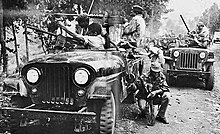
Joseph Kasa-Vubu, alternatively Joseph Kasavubu, was a Congolese politician who served as the first President of the Democratic Republic of the Congo from 1960 until 1965.

Moïse Kapenda Tshombe was a Congolese businessman and politician. He served as the president of the secessionist State of Katanga from 1960 to 1963 and as prime minister of the Democratic Republic of the Congo from 1964 to 1965.

Thomas Michael "Mad Mike" Hoare was an Irish military officer and mercenary who fought during the Simba rebellion and was involved in carrying out the 1981 Seychelles coup d'état attempt.
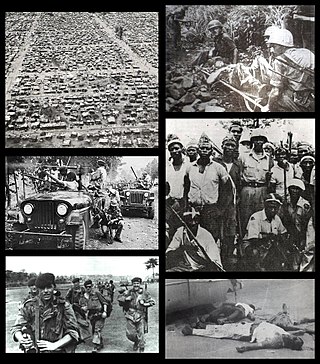
The Congo Crisis was a period of political upheaval and conflict between 1960 and 1965 in the Republic of the Congo. The crisis began almost immediately after the Congo became independent from Belgium and ended, unofficially, with the entire country under the rule of Joseph-Désiré Mobutu. Constituting a series of civil wars, the Congo Crisis was also a proxy conflict in the Cold War, in which the Soviet Union and the United States supported opposing factions. Around 100,000 people are believed to have been killed during the crisis.
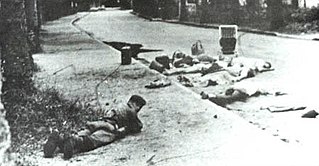
Operation Dragon Rouge was a hostage rescue operation in the Democratic Republic of the Congo conducted by Belgium and the United States in 1964. The operation was led by the Belgian Paracommando Regiment to rescue hostages held by Simba rebels in the city of Stanleyville.
Jean "Black Jack" Schramme was a Belgian mercenary and planter. He managed a vast estate in the Democratic Republic of the Congo until 1967.
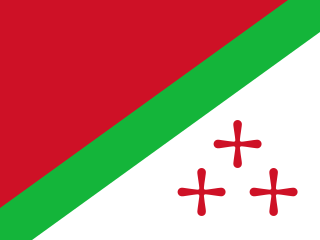
The State of Katanga, also known as the Republic of Katanga, was a breakaway state that proclaimed its independence from Congo-Léopoldville on 11 July 1960 under Moise Tshombe, leader of the local Confédération des associations tribales du Katanga (CONAKAT) political party. The new Katangese state did not enjoy full support throughout the province and was constantly plagued by ethnic strife in its northernmost region. It was dissolved in 1963 following an invasion by United Nations Operation in the Congo (ONUC) forces, and reintegrated with the rest of the country as Katanga Province.
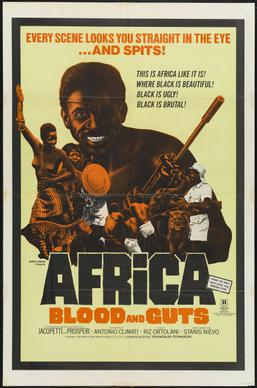
Africa Addio is a 1966 Italian mondo documentary film co-directed, co-edited and co-written by Gualtiero Jacopetti and Franco E. Prosperi with music by Riz Ortolani. Jacopetti and Prosperi had gained fame as the directors of Mondo Cane in 1962.

Dark of the Sun is a 1968 British adventure war film starring Rod Taylor, Yvette Mimieux, Jim Brown, and Peter Carsten. The film, which was directed by Jack Cardiff, is based on Wilbur Smith's 1965 novel, The Dark of the Sun. The story about a band of mercenaries sent on a dangerous mission during the Congo Crisis was adapted into a screenplay by Ranald MacDougall. Critics condemned the film on its original release for its graphic scenes of violence and torture.

The Simba rebellion, also known as the Orientale revolt, was a regional uprising which took place in the Democratic Republic of the Congo between 1963 and 1965 in the wider context of the Congo Crisis and the Cold War. The rebellion, located in the east of the country, was led by the followers of Patrice Lumumba, who had been ousted from power in 1960 by Joseph Kasa-Vubu and Joseph-Désiré Mobutu and subsequently killed in January 1961 in Katanga. The rebellion was contemporaneous with the Kwilu rebellion led by fellow Lumumbist Pierre Mulele in central Congo.

The White Legion was a mercenary unit during the First Congo War (1996–97) employed on the side of Zaire President Mobutu Sese Seko. This group of several hundred men, mostly from former Yugoslavia, was given the task of defending the city of Kisangani and training Zairean troops. This effort was largely unsuccessful and in mid-March 1997 the mercenaries left the country.

The Katangese Gendarmerie, officially the Katangese Armed Forces, was the paramilitary force of the unrecognized State of Katanga in Central Africa from 1960 to 1963. The forces were formed upon the secession of Katanga from the Republic of the Congo with help from Belgian soldiers and former officers of the Force Publique. Belgian troops also provided much of the early training for the Gendarmerie, which was mainly composed of Katangese but largely led by Belgians and later European mercenaries.
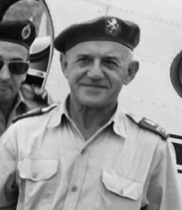
Frédéric Vandewalle was a Belgian colonel and diplomat in the Belgian Congo and independent Congo. He was an influential figure right before and after Congo's independence from Belgium. He was one of the organisers of the Katangese secession and led Operation Ommegang against the Simba rebellion during the Congo Crisis. His precise role in the assassination of Patrice Lumumba is the subject of debate among historians.

The 5 Commando was a mercenary unit of the Congolese National Army formed in response to the Simba rebellion. They were trained to be commandos, and had their own air support unit. 5 Commando was active from 1964 to 1967.
Mister Bob is a 2011 French drama film directed and co-scripted by Thomas Vincent.
Operation White Giant was a military offensive conducted by the forces of the Democratic Republic of the Congo and its allies to retake northeastern Orientale Province from insurgents during the Simba rebellion. The operation succeeded in its aims, cutting off the Simba rebels from supply by their allies in Uganda and Sudan.
Operation Violettes Imperiales was a military offensive conducted by the forces of the Democratic Republic of the Congo in northern Orientale Province against insurgents during the Simba rebellion. The operation succeeded in its aims, retaking the towns of Buta and Bondo as well as cutting rebel supply routes to the Central African Republic.
The 4th Commando Brigade was a unit of the Biafran Armed Forces. The brigade was created by order of Colonel C. Odumegwu Ojukwu in April 1968.
The Babies of Biafra was a Biafran aviation unit. Foreign mercenaries and Igbo served in the squadron.
Operation South was a military offensive conducted by the forces of the Democratic Republic of the Congo in Kivu against insurgents during the Simba rebellion. It was carried out by the DR Congo's regular military, the Armée Nationale Congolaise (ANC), mercenaries, and various foreign soldiers employed by Belgium and the United States. The operation aimed at destroying the remaining Simba strongholds and ending the rebellion. Though the insurgents were supported by allied Communist Cubans under Che Guevara and Rwandan exile groups, the operation resulted in the conquest of most rebel-held areas and effectively shattered the Simba insurgents.
